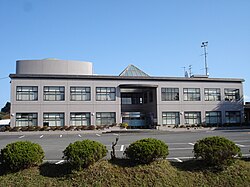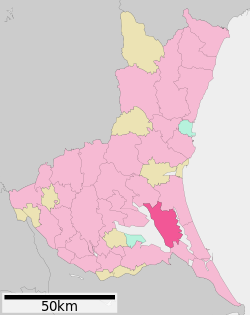Namegata
City in Kantō, Japan From Wikipedia, the free encyclopedia
Namegata (行方市, Namegata-shi) is a city in Ibaraki Prefecture, Japan. As of 1 July 2020[update], the city had an estimated population of 32,144 in 11,412 households and a population density of 144.5 persons per km2. The percentage of the population aged over 65 was 35.9%.[1] The city's total area is 222.48 square kilometres (85.90 sq mi).
Namegata
行方市 | |
|---|---|
 Namegata city hall | |
 Location of Namegata in Ibaraki Prefecture | |
| Coordinates: 35°59′25.8″N 140°29′20.5″E | |
| Country | Japan |
| Region | Kantō |
| Prefecture | Ibaraki |
| Area | |
• Total | 222.48 km2 (85.90 sq mi) |
| Population (September 2015) | |
• Total | 31,960 |
| • Density | 140/km2 (370/sq mi) |
| Time zone | UTC+9 (Japan Standard Time) |
| Tree | Ginkgo biloba |
| Flower | Lilium auratum |
| Bird | Egret |
| Phone number | 0299-72-0811 |
| Address | Aso 1561-9, Namegat-shi, Ibaraki-ken 311-3892 |
| Website | Official website |


Geography
Namegata is in south-central Ibaraki Prefecture, bordered by Lake Kasumigaura to the east and Lake Kitaura to the west. It is about 70 kilometers from central Tokyo and about 40 kilometers from the prefectural capital at Mito.
Surrounding municipalities
Ibaraki Prefecture
Climate
Namegata has a Humid continental climate (Köppen Cfa) characterized by warm summers and cool winters with light snowfall. The average annual temperature in Namegata is 14.1 °C. The average annual rainfall is 1410 mm, with September being the wettest month. The temperatures are highest on average in August, at around 25.8 °C, and lowest in January, at around 3.4 °C.[2]
Demographics
Per Japanese census data,[3] the population of Namegata has declined over the past 40 years.
| Year | Pop. | ±% |
|---|---|---|
| 1920 | 33,789 | — |
| 1930 | 35,996 | +6.5% |
| 1940 | 38,680 | +7.5% |
| 1950 | 49,391 | +27.7% |
| 1960 | 47,549 | −3.7% |
| 1970 | 42,589 | −10.4% |
| 1980 | 42,660 | +0.2% |
| 1990 | 42,990 | +0.8% |
| 2000 | 41,465 | −3.5% |
| 2010 | 37,611 | −9.3% |
| 2020 | 32,185 | −14.4% |
History
During the Edo period, portions of what later became the city of Namegata were controlled by the Asō Domain, a feudal domain under the Tokugawa shogunate. The towns of Asō and Tamazukuri were created by establishing the modern municipalities system on April 1, 1889. The village of Kitaura was established on April 1, 1955, and elevated to town status on October 1, 1997. The three towns merged to form the city of Namegata on September 2, 2005.
Government
Namegata has a mayor-council form of government with a directly elected mayor and a unicameral city council of 18 members. Namegata contributes one member to the Ibaraki Prefectural Assembly. Regarding national politics, the city is part of Ibaraki 2nd district of the lower house of the Diet of Japan.
Economy
The economy of Namegata is primarily agriculture, with aquaculture on Lake Kasumigaura taking a predominant role.
Education
Namegata has 16 public elementary schools, four public middle schools operated by the city government, and two public high schools operated by the Ibaraki Prefectural Board of Education.
Transportation
Railway
- Namegata does not have any commercial passenger rail service.
Highway
Local attractions
Namegata has many attractions, including:
- Hitachi Seaside Park
- Kasumigaura Fureai Land
- Namegata Farmers Village
- Sairen-ji Temple
Noted people from Namegata
- Hiromi Nagasaku, actress, singer
- Fukushiro Nukaga, politician
- Hideaki Ozawa, a professional football player
References
External links
Wikiwand - on
Seamless Wikipedia browsing. On steroids.



